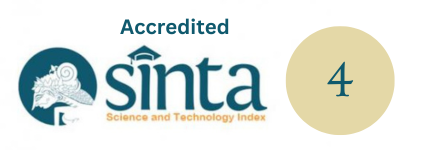Composition of Pacepuk Sang Hyang | Karya Musik Pacepuk Sang Hyang
DOI:
https://doi.org/10.59997/jurnalsenikarawitan.v1i3.307Kata Kunci:
gending, pacepuk sang hyang, komposisi baruAbstrak
Karya musik Pacepuk Sang Hyang merupakan sebuah karya musik yang lahir dari respon terhadap pertemuan spirit gending serta karakter Sang Hyang Dedari, Sang Hyang Jaran, dan Sang Hyang Bojog. Ketertarikan pencipta untuk menggunakan tiga jenis gending Sang Hyang tersebut sebagai sumber penciptaan terletak pada 1) keunikan konsep arah nada pembentuk pola melodinya, 2) konsep ngubeng juga menjadi daya tarik dari melodi gending Sang Hyang, 3) Cenderung laras yang digunakan pada gending-gending Sang Hyang adalah laras slendro. Esensi dari ketiga gending dan karakter Sang Hyang ini kemudian diolah menjadi suatu karya musik baru mengingat ciri-ciri karya musik Pacepuk Sang Hyang berdasar dari olah kreatif intelektual dan mengarah pada paradigma musik untuk musik. Secara struktural, karya musik Pacepuk Sang Hyang dibagi ke dalam tiga bagian garapan. Bagian pertama, pencipta terinspirasi dari Sang Hyang Bojog. Bagian kedua, pencipta terinspirasi dari Sang Hyang Jaran. Bagian ketiga, pencipta terinspirasi dari Sang Hyang Dedari. Tujuan dari penciptaan karya musik Pacepuk Sang Hyang adalah mengangkat sumber garapan berupa kesenian Sang Hyang yang merupakan kearifan lokal yang kini kian meredup dengan menggarap ulang kembali ke dalam kemasan yang berbeda melalui proses kreatif. Tahap merealisasikan tertuang pada proses kreativitas yang di dalamnya berisikan penjajagan, percobaan, dan tahap pembentukan.
Unduhan
Referensi
Bandem, I Made. (1983). Ensiklopedi Tari Bali. Denpasar: Akademi Seni Tari Indonesia Denpasar.
Bandem, I Made. (1986). Prakempa Sebuah Lontar Gamelan Bali. Denpasar: Akademi Seni Tari Indonesia Denpasar.
Bandem, I Made. (1991). Ubit-Ubitan Sebuah Teknik Permainan Gamelan Bali. Denpasar: Sekolah Tinggi Seni Indonesia Denpasar.
Dibia, I Wayan.( 2003). Bergerak Menurut Kata Hati, Metoda Baru Dalam Menciptakan Tari (Terjemahan dari Moving From Within A New Method for Dance Making oleh Alma M. Hawkins.Bandung: Ford Foundation dan Masyarakat Seni Pertunjukan Indonesia.
Djelantik, A.A.M . (2008). Estetika Sebuah Pengantar. Jakarta: Masyarakat Seni Pertunjukan Indonesia (MSPI) dengan Ford Foundation.
I Gusti Ketut Anom, Dkk. (2009). Kamus Bali-Indonesia: Beraksara Latin Dan Bali. Denpasar: Badan Pembina Bahasa, Aksara, dan Sastra Bali Provinsi Bali.
Kartika, Dharsnono Sony. (2007). Estetika. Bandung: Rekayasa Sains.
Proyek Penggalian/Pembinaan Seni Budaya Klasik (Tradisional) dan Baru. (1980/1981). Evolusi Tari Bali. Denpasar: Proyek Penggalian/Pembinaan Seni Budaya Klasik (Tradisional) dan Baru.
Santosa, H., Lubis, N. H., Sofianto, K., & Mulyadi, R. (2017). The Story of the War Gamelan Is A Story of Truth. Mudra Jurnal Seni Budaya, 31(3). https://doi.org/10.31091/mudra.v31i3.46.
Sudirga, I. K. (2017). Pasantian Sebagai Sumber Inspirasi Riset dan Kreativitas. Mudra Jurnal Seni Budaya, 32(1). https://doi.org/10.31091/mudra.v32i1.66.
Sugiartha, I Gede arya. (2012). Kreativitas Musik Bali Garapan Baru, Perspektif Cultural Studies. Denpasar: UPT Penerbitan Institut Seni Indonesia Denpasar.
Suharman. (2011). Kreativitas : Teori Dan Pengembangan. Surabaya: Laros.
Sukerta, Pande Made. (2009). Ensiklopedi Karawitan Bali. Surakarta: ISI Press Solo.
Sukerta, Pande Made. (2011). Metode Penyusunan Karya Musik (Sebuah Alternatif). Surakarta: ISI Press Solo.
Watra, I Made Yudabakti dan I Wayan. 2007. Filsafat Seni Sakral Dalam Kebudayaan Bali. Surabaya: Paramitha.








